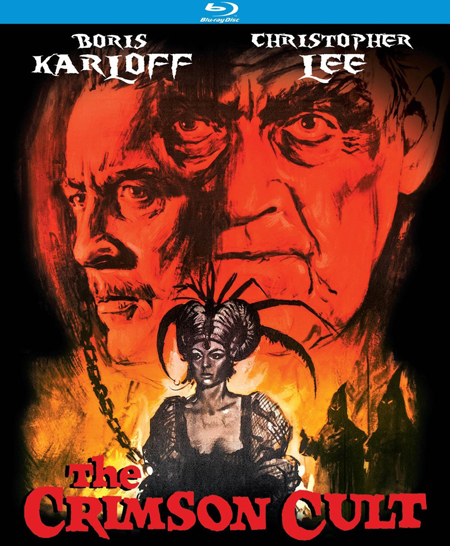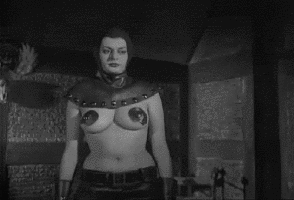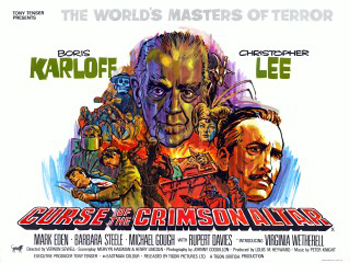
BY LEE PFEIFFER
Christopher Lee and Boris Karloff collectively made countless films that varied widely in terms of quality. However, they always brought dignity to every role they performed. Sadly, the two icons of the horror film genre only worked together twice.The first time in the late 1950s in "Corridors of Blood" and the second and last time in what turned out to be the final film of Karloff's career, the 1968 Tigon Films production of "The Crimson Cult" (released in the UK as "Curse of the Crimson Altar" and in some territories as "The Crimson Altar" and "Black Horror"). Karloff barely got through the arduous shoot during a particularly cold and unpleasant British winter. However, always the ultimate professional, he persevered and continued the film until completion, even after having been hospitalized with pneumonia. The result is a film that is not particularly well-loved by horror film fans but which this writer enjoyed immensely on my first viewing, which came courtesy of the Blu-ray release from Kino Lorber Studio Classics. Perhaps the film looked better to me than it should have. It's got some loose plot points and the production doesn't fully utilize the skills of it's marvelous cast, which includes character actor Michael Gough and the iconic Barbara Steele. However, given the fact that we don't get lineups of great stars like this any more, I found the entire movie to be a joy to watch (despite of- or perhaps because of- it's sometimes blatant exploitation scenes.)
Things get off to a rather rollicking start with the very first frames of the movie which depict a woman clad only in leather panties and pasties who is mercilessly whipping another sexy young woman who is chained to an altar in a dungeon-like environment. Watching the action is Peter Manning (Denys Peek), who we learn is a respected antiques dealer who runs a high end shop with his brother Robert (Mark Eden). Peter looks completely out of place in this S&M scenario, even more so when we see the others who are witnessing what becomes evident as a Satanic Black Mass ceremony, which is taking place amid other scantily-clad men and women. Peter is approached by an exotic beauty who we will later learn is the reincarnation of a notorious witch named Lavinia, who was executed by local villagers a few centuries ago. As played by real life exotic beauty Barbara Steele in a largely wordless role, the character exudes both danger and sexual deviancy. She insists that Peter sign an ancient ledger after which he is given a dagger which he uses to promptly murder the young woman who is chained to the table.

The scene then switches to the antique shop where we find Robert concerned about his brother's whereabouts. He tells his secretary that Peter had gone to search for antiques for a few days in the remote rural village of Greymarsh, which coincidentally is the ancestral home of the Manning family. The only clue he has to his brother's movements is a cryptic note he had written to Robert from a manor house in the village. Robert decides to visit the house to see if he can trace Peter's location. Naturally, he chooses to arrive at the place in the dead of night and finds the villagers are engaged in riotous celebrations for an annual festival that rather tastelessly celebrates the execution of witches in a bygone era. The locals playfully recreate pagan rituals including the execution of an effigy of Lavinia. Arriving at Greymarsh Manor, Robert finds a wild party underway with a group of young people in an orgy-like state. The girls are pouring champagne over their nearly naked bodies and there are "cat fights" intermingled with lovemaking. Robert is understandably amused and fascinated. He makes the acquaintance of Eve (Virginia Wetherell), a fetching blonde with a flirtatious nature who informs him that she is the niece of the manor's owner, a sophisticated and erudite man named Morley, who greets Robert warmly but denies any knowledge of his brother. Morley says that he can't explain how Robert received a note from Peter on Greymarsh Manor stationary but nevertheless invites Robert to stay a few days at the manor while he continues his investigation. Predictably, Robert and Eve form a romantic bond in short order and she assists him in his efforts to find Peter. Meanwhile, Robert is introduced to Professor John Marsh (Boris Karloff), an elderly, wheelchair-bound academic who is the village's most prominent local historian. Fittingly, he is also a collector of ancient torture devices.

Most of the film centers on Robert and Eve attempting to track down Peter's doings in the village and his present whereabouts. It becomes pretty obvious that either Morley and/or Marsh are hiding some explosive secrets. The only question for the viewer is whether one or both of them have been complicit in Peter's vanishing. Robert's stay at the manor house is decidedly mixed experience for him. In the evenings he gets to enjoy rare, expensive liquors as he sits around chatting with Morley and Marsh. He also gets a willing bed mate in Eve. However, he is terrified by recurring nightmares that find him in the midst of a Black Mass ceremony where he finds his brother. In these bizarre dreams, Lavinia insists that Robert sign the ancient ledger, as Peter did, but Robert steadfastly refuses because he believes he will be murdered once he does. Robert discovers that his arm has been seriously cut by a knife- a key part of his nightmare. He thus begins to suspect that these aren't dreams at all, but real experiences that are taking place when he is in drugged condition. A trail of clues leads to some red herrings until Robert and Eve discover that the manor house has a hidden room where it is apparent Satanic ritual ceremonies are taking place. From that point, key plot devices begin to fall into place with a few minor surprises along the way. The movie is a great deal of fun from start to finish and seeing both Lee and Karloff on screen together is a real treat. Michael Gough makes welcome frequent appearances as an Igor-like butler who tries to warn Robert about the dangers of staying at Greymarsh Manor and Rupert Davies has a nice cameo as the local vicar. A few other observations: Virginia Wetherell is a first rate leading lady in this type of genre film so the fact that she never achieved greater name recognition seems unjust. Also the production design is first rate, as it generally is in British horror movies of this period. Kudos also to veteran director Vernon Sewell who crafts a consistently interesting film from a script that has some loose ends and weak plot points. He also has to contend with a good amount of T&A that seems to be inserted largely for exploitation reasons. The film's dramatic conclusion is meant to be intriguing and ambiguous but comes across as somewhat unsatisfying. However, in the aggregate, the movie is a great deal of fun- largely due to the presence of Lee, Karloff and Steele.
The film has been released by Kino Lorber as a Blu-ray special edition under its American title. The company has wisely ported over some of the content of special bonus materials that were available on a previous UK-only Blu-ray edition. These include a wonderful commentary track with Barbara Steele and well-known horror film historian David Del Valle, who has also produced a number of documentaries. Del Valle is uniquely suited to conduct the discussion of the film, as he personally knew many of the legendary figures of the horror film genre and his knowledge is encyclopedic. He and Steele have a good rapport because they are old friends. Both of them, however, denounce the movie because of its missed opportunities. The main criticisms revolve around the misuse of Christopher Lee and Boris Karloff in their only film together. Del Valle feels that there isn't much for them to do other than sit around parlors sipping drinks. He points out that this was Karloff's last film and he was in poor health during its production, yet was valiant enough to complete filming- and insist that a scene be rewritten so he could rise from his wheelchair, an act of defiance and courage considering his fragile state. Steele bemoans the fact that the screenwriters didn't allow her character to share any scenes with either Lee or Karloff, although she did spend time with them off set and clearly adored both men. However, the way the story is structured simply wouldn't allow the three characters to interact without fundamentally changing the story. One can understand Steele's frustrations as an actress, however, in not having the opportunity to share screen time with these cinematic legends. Del Valle also dismisses leading man Mark Eden (who resembles young George Lazenby) as a lightweight, a charge that seems debatable. I personally found Eden to be a likable and charismatic leading man. Both Del Valle and Steele acknowledge the film has some merits but you'd barely know it by the time they get done slicing it up scene by scene. Steele also provides some very interesting discussions about her non-horror films including quitting the production of "Flaming Star" in which she was Elvis Presley's leading lady. She also discusses her work with Fellini. In all, I found myself not agreeing with Steele and Del Valle's overall assessment of "The Crimson Cult" but I did find this to be an excellent commentary track, filled with wonderful anecdotes.
The Kino Lorber Blu-ray contains other bonus extras. The most interesting is an interview with composer Kendall Schmidt, who relates why he receives screen credit for the musical score in the video versions of the film. (Peter Knight is still the composer of record on the theatrical prints.) Schmidt, who is now a well-regarded photographer, relates that when Orion acquired video rights to the American International Pictures library in the mid-1980s, there were many films they could not secure the music rights to. Thus, Schmidt, who was a 24 year old starving composer, was hired to re-score these films. In some cases, he emulated the original composer's scores while in most other cases he created wholly original compositions. His score suits this film well but, not having seen the theatrical version, I can't compare his work with Peter Knight's. The Blu-ray also includes both the U.S. and British trailers with their respective title differences.
It should be pointed out that the picture quality of this release is as close to perfect as you can get. Colors practically leap off the screen and the transfer does full justice to the production design. In all, I found this to be a first rate release of an extremely underrated film from the "Golden Age" of British horror productions.
CLICK HERE TO ORDER FROM AMAZON